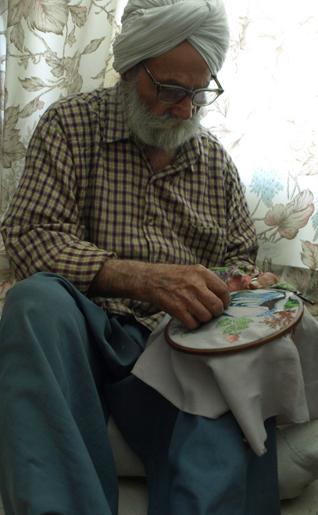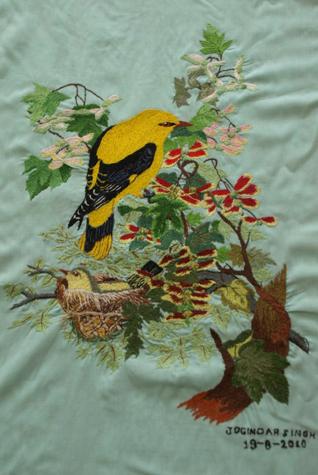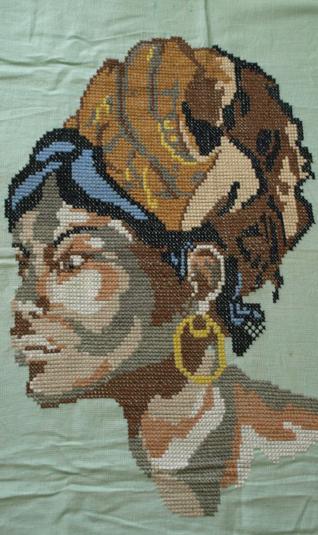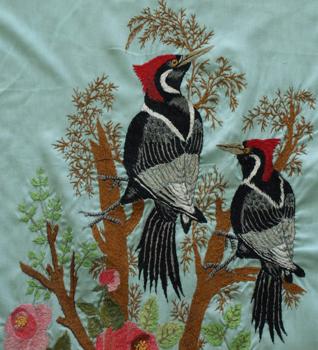Art
Fingers of Magic: The Art & Craft of Joginder Singh
HANDS OF INDIA
When what looked like a painting turned out to be embroidery under the lens, my eyes went to the name of the artisan, expecting it to be some woman ... It spelt - "Joginder Singh".
There are 63 embroidery works by Sardar Joginder Singh in the Nature Gallery of the Government Museum and Art Gallery at Sector 10, Chandigarh, Punjab.
An avid bird-watcher, as I moved from one work to the other, the precision and the painstaking detailing of each plumage and characteristic of the bird made my jaw drop frequently.
Curiosity piqued, on enquiring I found out that the artist was a 91-year old Sardar who has settled in Mohali after roaming around the world as a soldier.
Thus started my amazing discovery of an artist - his works and his ‘Punjabiyat' as he proudly entertained me for two days, answered myriad questions, showed me priceless works out of his collection, and welcomed me whole-heartledly to his hearth and his heart.
I have met many master craftsmen - from the quirky to the ones who refused to speak with me or show me their work out of fear that I will copy it. I went hoping for a big family with a big larger-than-life Sardar as the old patriarch of all of them - an image fuelled by countless Bollywood movies.
The person I met, however, was a single, 91-year old, small guy - he says jokingly, he was so busy with life that he forgot to marry - who lives all alone as a care-taker in the house of his friend, who is settled with his family in the United Kingdom.
On entering a neat and clean house, my eyes fell on a bird in the process of embroidery, along with its photos and sketches lying around.
Sardar Joginder Singh ji cooks his own meal, washes his clothes and does 8-9 hours of embroidery every day. An age which is routinely populated by people suffering from various kinds of dementia, his memory is still razor sharp, and he is able to recount every single small detail of his life, many backed by supporting documents of reference provided to him by his officers in the army and subsequent civil services that he did.
Other than embroidery, he has collected 38 kgs. of rare and antique coins (he is an expert in Kushan dynasty coins), 11,000 match boxes and 200 odd bird feathers - the complete collection is now displayed at the museum of Patiala after being donated by the Sardar.
With no formal education, he started his life by losing his parents in quick succession (his father, a tax officer of the Sangrur ruler, was killed by dacoits while on his way back after collecting the taxes), was brought up by the Sikhs in the village of Rajo Majra, and spent most of his childhood grazing cattle.
Joining the Royal Artilerry as a soldier, he served in the North-East, the North-West frontier, Java and Sumatra.
He remembers his first prize for an embroidery work very clearly - it was at a competition in 1945 organised by his unit stationed at the North-West Frontier. He won the second prize for an embroidered parrot. The grand prize included a princely sum of 60 silver coins, a letter of appreciation and a 10 day leave.
To date, he has won 48 major and minor competitions, and proudly carries every letter, certificate and endorsement written by a motley crowd of government officers, royalty, school principals and various other organisations that he volunteered for. Wherever he stayed, his collection of stamps, coins, feathers, match-boxes and embroidered works were displayed in various schools, colleges and many functions, and he has scores of letter of appreciation which tell in detail how enthusiastically he shared his treasures with the local people, children in particular.
When I ask him what got him interested in embroidery - something typically associated with women - he tells me it was the dupattas worn traditionally by brides on their wedding day. Women in his village - both mothers and mother-in-laws - would spend years embroidering a dupatta to be gifted to the girl whom they would either give away or receive in marriage. The dupatta given by the mother-in-law while entering the house for the first time would go to the funeral pyre along with the bride when she died.
It is this habit of being involved with objects of great cultural value that have educated this unlettered and frail gentleman. Throughout the time I speak with him, I detect only a faint tint of regret at not having gone to school, otherwise he is the most content and happy old man I have met. He humbly wonders at his own life and the amazing way it turned out for him.
So far, he has never sold any work or collectible to anyone. He has gifted hundreds of works (each one takes about 3-6 months) and feels happy that they occupy prized places wherever they are displayed. His proudest moment came when a whole section of the Nature Gallery at the Chandigarh museum was dedicated to his embroidery work.
Meeting Sardar Joginder Singh has been one of life's biggest lessons for us - in perseverance, grace and humility. Having lived a life needing umpteen things to be happy, his contentment with himself and his life, his fierce independence at the age of 91, his ability to give away all that he so painstakingly collects or creates, and his very few needs now, made me realize that what we chase all around lies only within us.
One reason I love working at "Hands of India" is these kinds of encounters of a different kind - meeting a guy who has actually lived his life sharing and giving away everything he worked for, and who even at 91 finds happiness in his work.
Through Hands Of India, we work with women embroiderers from all over the county, and its but apt that the finest living proponent of that art is lending his blessings and support.
Sardar Joginder Singh inaugurated the Hands Of India Chandigarh Exhibition, along with Padma Shri Neelam Man Singh Chowdhry, yesterday - on Saturday, April 2, 2011.
It was an absolute honour and privilege for us to show him our work, and we hope that his dream of completing 100 works of bird embroidery is fulfilled soon.
April 3, 2011
Conversation about this article
1: R. Singh (Canada), April 03, 2011, 9:17 PM.
Wonderful. A talented artist indeed!
2: Rubal (Sangrur, Punjab), September 24, 2012, 3:19 AM.
Great man. Still doing work in Sangrur with his nephew, Amarjit Singh.






